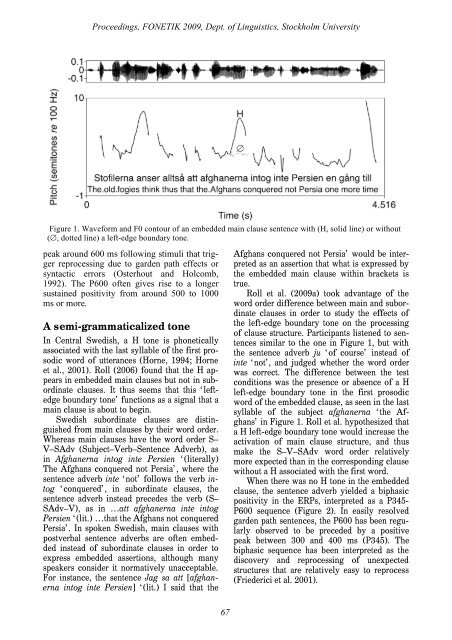Proceedings Fonetik 2009 - Institutionen för lingvistik
Proceedings Fonetik 2009 - Institutionen för lingvistik
Proceedings Fonetik 2009 - Institutionen för lingvistik
You also want an ePaper? Increase the reach of your titles
YUMPU automatically turns print PDFs into web optimized ePapers that Google loves.
<strong>Proceedings</strong>, FONETIK <strong>2009</strong>, Dept. of Linguistics, Stockholm UniversityFigure 1. Waveform and F0 contour of an embedded main clause sentence with (H, solid line) or without(∅, dotted line) a left-edge boundary tone.peak around 600 ms following stimuli that triggerreprocessing due to garden path effects orsyntactic errors (Osterhout and Holcomb,1992). The P600 often gives rise to a longersustained positivity from around 500 to 1000ms or more.A semi-grammaticalized toneIn Central Swedish, a H tone is phoneticallyassociated with the last syllable of the first prosodicword of utterances (Horne, 1994; Horneet al., 2001). Roll (2006) found that the H appearsin embedded main clauses but not in subordinateclauses. It thus seems that this ‘leftedgeboundary tone’ functions as a signal that amain clause is about to begin.Swedish subordinate clauses are distinguishedfrom main clauses by their word order.Whereas main clauses have the word order S–V–SAdv (Subject–Verb–Sentence Adverb), asin Afghanerna intog inte Persien ‘(literally)The Afghans conquered not Persia’, where thesentence adverb inte ‘not’ follows the verb intog‘conquered’, in subordinate clauses, thesentence adverb instead precedes the verb (S–SAdv–V), as in …att afghanerna inte intogPersien ‘(lit.) …that the Afghans not conqueredPersia’. In spoken Swedish, main clauses withpostverbal sentence adverbs are often embeddedinstead of subordinate clauses in order toexpress embedded assertions, although manyspeakers consider it normatively unacceptable.For instance, the sentence Jag sa att [afghanernaintog inte Persien] ‘(lit.) I said that theAfghans conquered not Persia’ would be interpretedas an assertion that what is expressed bythe embedded main clause within brackets istrue.Roll et al. (<strong>2009</strong>a) took advantage of theword order difference between main and subordinateclauses in order to study the effects ofthe left-edge boundary tone on the processingof clause structure. Participants listened to sentencessimilar to the one in Figure 1, but withthe sentence adverb ju ‘of course’ instead ofinte ‘not’, and judged whether the word orderwas correct. The difference between the testconditions was the presence or absence of a Hleft-edge boundary tone in the first prosodicword of the embedded clause, as seen in the lastsyllable of the subject afghanerna ‘the Afghans’in Figure 1. Roll et al. hypothesized thata H left-edge boundary tone would increase theactivation of main clause structure, and thusmake the S–V–SAdv word order relativelymore expected than in the corresponding clausewithout a H associated with the first word.When there was no H tone in the embeddedclause, the sentence adverb yielded a biphasicpositivity in the ERPs, interpreted as a P345-P600 sequence (Figure 2). In easily resolvedgarden path sentences, the P600 has been regularlyobserved to be preceded by a positivepeak between 300 and 400 ms (P345). Thebiphasic sequence has been interpreted as thediscovery and reprocessing of unexpectedstructures that are relatively easy to reprocess(Friederici et al. 2001).67
















